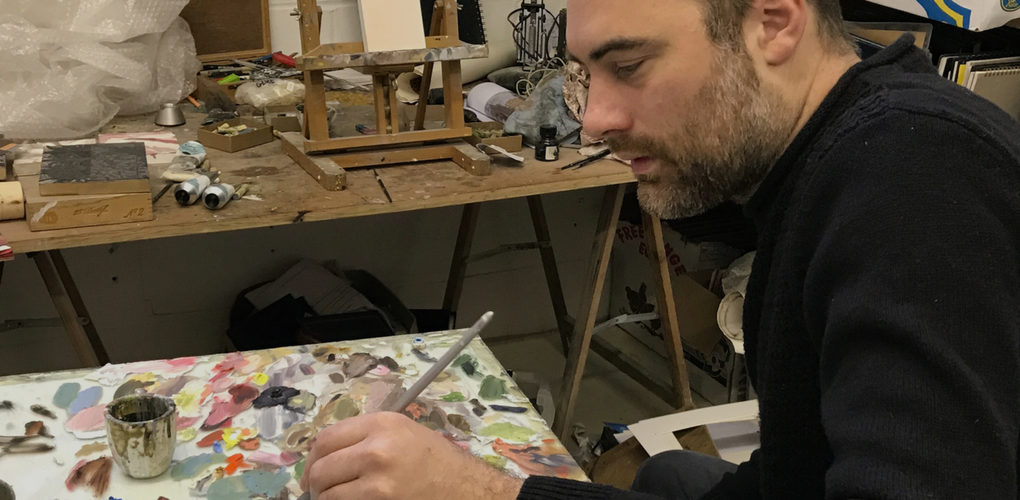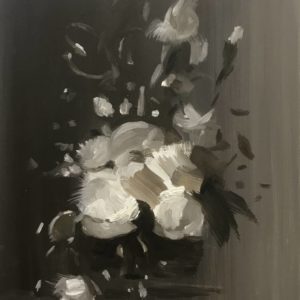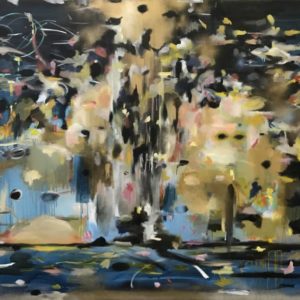One to Watch
 Alex Fox Indulges in the Possibilities
Alex Fox Indulges in the Possibilities
Alex Fox’s evolving style and practice stays grounded in his interest in the construction of making images. With a strong graphic sensibility and satirical approach, Alex sources inspiration from the Dutch masters and his favorite cartoonists, examining the environments of everyday life on his canvases. His explorations in oil painting are preceded by detours in film, sculpture and printmaking– endeavours which have informed his practice with a paintbrush.
Alex is based in Hackney, London. He received his MFA with Distinction from the City and Guilds of London Art School. His paintings and prints have been exhibited widely at galleries and fairs across London, and his work is on permanent display at the Stratford Olympic Village in the UK.
What are the major themes you pursue in your work?
I’m less preoccupied with themes and more interested in the mechanics of making images. For instance I’m as much of a fan of cartoons as I am of great painting – I ask myself how can I combine the two in my work? I love the pared down language of the former but I want indulge in the possibilities of oil painting too. There are motifs which tend to resurface in my work periodically; the still life, bubbles of everyday exotica which you might casually encounter – microcosms of life that surround us but we rarely notice. I enjoy recreating these environments in paint.
How did you first get interested in your medium, and what draws you to it specifically?
I began using oil paints when I was a teenager and I started with trepidation – obviously there is such a weight attached to it, it was intimidating. I was used more to working on paper with gouache. At art school I didn’t really paint at all, it was only later when I was heavily outnumbered by painters that I became interested in it as a medium again. I was inspired by their fanaticism, which was almost cultish. That said, I don’t really see a hierarchy between oil painting or drawing for instance.
How has your style and practice changed over the years?
My style and practice has changed enormously over the years. It feels like it’s been a very long journey with interesting detours. I wanted explore so many different ways of making art. I think my appetite in some respects has been sated but I feel like I’m leaving possibilities open for returning to previous projects and themes. I’ve made videos and films that probably owed more to documentary than art. I’ve made many series of prints, quite reductive, stark, and graphic, and also sculptures that were satirical in intent and quite classical in terms of inspiration.
Can you walk us through your process? Do you begin with a sketch, or do you just jump in? How long do you spend on one work? How do you know when it is finished?
I’m quite impatient so endless preparatory drawings aren’t for me. I tend to do quite a bit of research for images that might spark the beginning of an enquiry. It could be something about the tone or the way colors are off set against one another, the depth that engages me. Then it’s usually very quick. I will often get a background color down heavily thinned with turpentine so I can start working into it immediately. It’s risky because I need the rapidity. As soon as I start to get bogged down or make a wrong turn, the wrong sort of color or brushstroke, it tends to fail and it’s almost impossible to redeem.
The paintings that succeed are the ones were everything connects, almost on a subconscious level and the risks I take have paid off. When a painting is finished it is usually pretty obvious to me – some of the more abstracted paintings are more open ended and I sometimes return to them periodically to add new aspects or remove them. When they don’t work it’s draining– they have to be put away until you are ready to have another go at them.
Who are some of your favorite artists?
I particularly love Dutch artists – Rembrandt is the absolute pinnacle – his self-portraits and etchings. I also love some of his weirder compatriots, Hercules Seghers because of his unearthly landscapes for instance. Rachel Ruysch’s flower pieces are also endlessly fascinating – it’s easy to dismiss them initially but when you look closer you realize everything is there. I also like more obscure artists like Leon Spilleart for the peculiar effects of light and shade in his work. I enjoy work with a strong graphic sensibility and a sense of humor – like that of Ed Ruscha and Sigmar Polke for instance. I also admire cartoonists like Robert Crumb and Chris Ware, Herge and Lorenzo Mattotti, all incredible draughtsmen.
What was the best piece of advice given to you as an artist?
Advice is a funny one. If anybody gives me advice the temptation is to do the exact opposite – usually that works well for me but not always! Really it’s a process of finding your rhythm and your approach, and no amount of advice is going to help you with that.

















